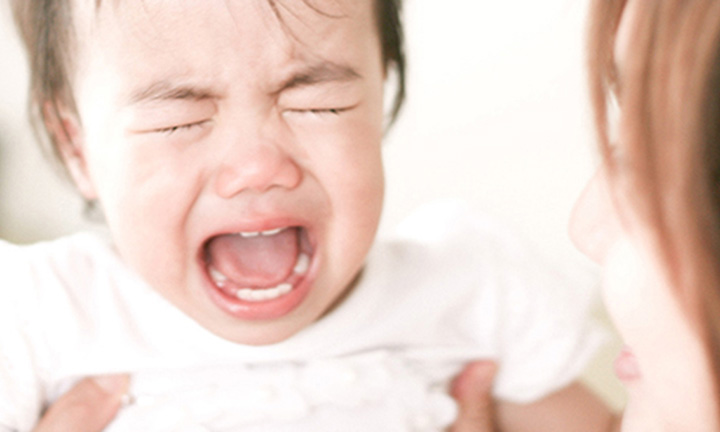
Baby Congestion: Causes, Remedies, & When to See a Healthcare Provider


Noticing your little one sniffling, breathing noisily, or struggling to feed? Baby congestion—whether in the nose or chest—can feel alarming, especially if you're not sure what's causing it. In many cases, it's mild and manageable at home. Still, it’s normal to wonder, “Is this something I should be worried about?”
Congestion often stems from colds, dry air, or irritants, but it can also be a sign of something more serious like RSV or pneumonia. Knowing what’s typical and when to seek medical attention can make a big difference in how you respond.
What You Can Do Right Now:
When to Call Your Healthcare Provider Immediately:
This guide provides quick, trusted answers to help you feel more confident, along with easy and safe ways to relieve newborn congestion at home, and the signs that indicate it’s time to seek medical help.
Why Your Baby’s Nose and Chest Are Congested
Baby congestion is very common in the first year. It can affect the nose, chest, or both, and usually happens when excess mucus builds up, making it harder for your little one to breathe comfortably.
A stuffy nose in a baby often results from inflammation and swelling inside the nasal passages, sometimes accompanied by mucus. This may cause noisy breathing, sniffling, or trouble feeding. Meanwhile, chest congestion happens when mucus builds up in the lungs or lower airways. This may cause a wet-sounding cough, wheezing, or general discomfort.
Understanding the difference between nasal and chest congestion is key to knowing how to respond at home and when to reach out to your baby’s healthcare provider for support.
Common Causes of Nasal Congestion in Babies
Babies may experience nasal congestion when the tissues inside the nose become inflamed and swollen, often due to excess mucus buildup. Babies’ nares are smaller than adults, making them more susceptible to noisy breathing or congestion due to small amounts of nasal fluid or mucus. Your baby's nasal blockage can make it harder for them to breathe through their nose, leading to discomfort, especially during feeding or sleep.
An upper respiratory infection is one of the most common causes of a stuffy nose in a baby. Baby cold symptoms may include nasal congestion, sneezing, coughing, and sometimes a low-grade fever.
Nasal congestion happens when the nose and surrounding tissues, including the blood vessels, become swollen with excess mucus, which often results in a "plugged" or blocked feeling.
Since babies can’t blow their noses, mucus tends to build up, making nasal blockage more persistent. Other triggers of a baby's nasal congestion can include exposure to dry air, allergens, or irritants like cigarette smoke.
Here are the common causes of a baby’s nasal congestion:
In most cases, a baby’s nasal congestion is mild and manageable at home. But if your little one seems to be having trouble breathing, feeding, or sleeping, reach out to your baby’s healthcare provider for guidance.
Chest Congestion Causes and Concerns
A baby's chest congestion is often caused by lower respiratory infections, most of which are related to respiratory infections like the common cold. These conditions may make breathing difficult for your baby and may lead to a persistent cough. They may also spread easily through respiratory droplets or contact with contaminated surfaces. Babies, especially newborns, are more vulnerable because their immune systems are still developing.
Since congestion is only a symptom of an underlying illness, your child must first get over the infection causing the illness for the congestion to completely clear. While chest congestion can often be treated at home, some cases may require a visit to your baby’s healthcare provider if the symptoms are linked to more serious infections, such as:
If your baby’s chest seems tight or you notice labored breathing, a worsening cough, or signs of distress, contact your little one’s healthcare provider right away. They can help determine if it’s something that requires treatment or further monitoring.
In Summary
Baby congestion—whether it’s a stuffy nose or chest congestion—is often a sign of a cold or another common respiratory virus. During their first year, babies are especially vulnerable to catching infections from close contact with others. In many cases, mild congestion can be managed with home care and comfort measures. However, if your baby’s symptoms worsen or seem tied to a more serious illness, your little one’s healthcare provider can evaluate the cause and recommend safe, effective treatment.
Curious about your baby's growth? Every baby develops at their own pace, but understanding what’s ahead can help you feel more prepared. Explore helpful insights and tips for each stage of your little one’s development in our baby development milestones.
How to Tell If Your Baby Is Congested
Your little one can’t explain how they’re feeling, but there are often clear signs of baby congestion that you can look out for. Whether it’s a stuffy nose or mucus in the chest, congestion may make it harder for your baby to breathe, feed, or sleep comfortably.
Recognizing early symptoms of baby congestion can help you respond with care and know when to reach out to your baby’s healthcare provider for support.
Signs of Nasal Congestion in Babies
Nasal congestion in babies usually occurs when the nasal passages become inflamed and filled with mucus, making it harder for your baby to breathe through their nose.
If you're wondering how to know if your baby has a stuffy nose, these signs can help guide you. Since babies can’t clear their own nasal passages, even mild blockage may lead to discomfort or irritability.
Symptoms of Chest Congestion
Chest congestion occurs when your baby’s lungs and airways are filled with mucus, which can make breathing difficult.
Signs of chest congestion in babies might include:
In some cases, these symptoms may point to a more serious infection, such as chest infection symptoms in your baby, which can include:
If your baby shows these signs or if their breathing seems particularly labored, it’s important to consult a healthcare provider to check for conditions like bronchiolitis or pneumonia.
The Difference Between a Dry and Wet Cough
Understanding the types of baby coughs can help you determine whether your little one is experiencing chest congestion or another underlying issue.
A wet cough in babies often sounds moist or phlegmy and is usually caused by mucus in the chest. These wet cough symptoms in babies may last longer than a runny nose and may suggest that your little one’s body is trying to clear mucus from the lungs. If your baby’s cough sounds wet, it could be a sign of baby chest congestion—it’s best to reach out to your baby’s healthcare provider, especially if your little one is under 2 months old.
A dry cough, on the other hand, usually sounds more irritated or harsh. A baby’s dry cough symptoms may point to conditions such as croup or whooping cough. Croup is characterized by a barking sound cough and a squeaking or whistling sound known as stridor, whereas whooping cough presents with a coughing fit and followed by a whooping sound and may cause trouble in breathing or apnea. If the cough is dry and your baby is wheezing, or if it seems to be worsening, it’s important to contact your baby’s healthcare provider for a proper diagnosis.
The main difference between a baby’s dry cough and a wet cough lies in what’s happening in your little one’s body: a wet cough typically means there’s mucus in the lungs. In contrast, a dry cough is usually caused by irritation or inflammation in the airways.
Be aware that experts do not recommend over-the-counter cough medicines for children younger than 6 years old, as they may cause serious side effects, such as slowed breathing.
In Summary
If your baby’s cough sounds “wet,” it could be a sign of mucus buildup in the chest. A dry, barking cough may suggest irritation or illness like croup. In either case, it’s best to consult your baby’s healthcare provider for evaluation and treatment guidance. Avoid giving your baby over-the-counter cough medicine unless your provider specifically recommends it.
Immediate Relief for Your Baby’s Nasal Congestion
If your little one has a stuffy nose, it may make feeding and sleeping more difficult. Providing quick relief for baby nasal congestion is important to help them breathe more comfortably. If you're wondering how to get rid of your baby’s stuffy nose, there are a few safe, effective steps you can try for baby nasal relief.
Quick Fixes for Stuffy Nose
If it appears that your infant has nasal congestion and it’s bothering them, you can follow this two-step stuffy nose treatment to help clear their nose. It’s often most helpful to do this every few hours, and especially 15 to 20 minutes before feeding or bedtime:
Be sure to wash the bulb syringe and any other tools with soap and water after each use to help prevent infections.
There are a few more baby nasal congestion remedies you can try alongside saline and suction to keep your baby more comfortable:
Effective Remedies for Chest Congestion in Babies
If your baby is struggling with chest congestion, several methods may help provide relief. Babies are especially vulnerable because their airways are small, and they aren’t yet able to clear mucus effectively on their own. Knowing how to relieve baby chest congestion may help you support your little one’s breathing and overall comfort.
To help your little one breathe more easily and reduce discomfort, try the following:
Home Remedies for Chest Congestion
You can also try a few simple, natural baby chest congestion remedies at home:
These home remedies can be highly effective for providing relief, but if your baby’s symptoms persist or worsen, always consult with a healthcare provider to ensure they get the appropriate care.
What Does the Color of Your Baby’s Mucus Mean?
The color of your baby’s mucus may provide insight into what’s going on in their body. While normal baby mucus is usually clear, shifts to white, yellow, green, or even blood-tinged can signal changes in their health.
Understanding your baby’s mucus color meaning may help you decide whether your little one is just dealing with mild congestion or if it might be time to check in with your little one’s healthcare provider. Here's a breakdown of what the color of your baby’s mucus could mean.
Clear Mucus: Normal or Mild Congestion
A baby's clear mucus is typically a good sign. It helps moisturize nasal passages and trap tiny irritants, such as dust or allergens. Clear mucus is often associated with normal mucus production or mild congestion due to allergies or the early stages of a cold.
White Mucus: Possible Cold
A baby's white mucus may indicate that your little one’s body is responding to a cold. White or cloudy mucus often becomes thicker as it loses water content and may be a sign of a minor viral infection. The presence of white mucus in babies suggests that a cold is progressing, but it isn’t necessarily a cause for concern.
Yellow Mucus: Infection Warning
When mucus turns yellow, it may mean your baby’s immune system is actively fighting off an illness. Yellow mucus symptoms could include ongoing congestion or fatigue. While a baby's yellow mucus doesn’t always mean something serious, it may suggest the presence of an infection, especially if your baby has other symptoms.
Green Mucus: Possible Sinus Infection
A baby's green mucus often appears after a few days of congestion and may indicate that the body is continuing to fight off an infection. If any green mucus symptoms are accompanied by fever, this could signal a viral illness or a sinus infection and should be evaluated by a healthcare provider.
Blood-Tinged Mucus: Irritation or Dryness
Bloody mucus in babies may result from dryness or irritation inside the nasal passages. Frequent nose wiping or suctioning may cause tiny capillaries to break, leading to a baby's bloody mucus. This is often harmless, but if bleeding persists or worsens, reach out to your little one’s healthcare provider.
When to Contact Your Baby’s Healthcare Provider
While color changes are usually part of your baby’s natural healing process, consult your baby’s healthcare provider if:
When to See Your Baby’s Healthcare Provider
Contact your little one’s healthcare provider right away if you notice any of the following symptoms, which may signal a severe illness or a more serious baby congestion:
If you’re ever unsure when to see a doctor for baby congestion, these symptoms are clear warning signs. When in doubt, it’s always safest to reach out.
Signs Your Baby Needs Immediate Medical Attention
If your baby is younger than 3 months old, it’s especially important to consult their healthcare provider early in any illness. Certain baby emergency symptoms require immediate evaluation, as they may point to more serious concerns.
These symptoms may indicate a baby's congestion emergency or another condition that requires prompt medical care.
Routine Health Checkups
Consistent baby health checkups play a key role in monitoring a baby’s health. These visits help track your baby’s growth, development, and any signs of congestion or other health concerns.
During check-ups, your healthcare provider will assess your child’s weight, length, and developmental milestones. They’ll also address any symptoms like a stuffy nose in infants, discuss the possible causes of a baby’s cough, and guide you through safe treatments and home care. They will also make sure your baby is up to date on immunizations.
Routine visits help support the early detection of issues, such as nasal or chest congestion, and provide reassurance for you as a parent. Before or after your appointment, you may also use tools like our Baby Growth Chart Calculator to follow your baby’s progress at home.
FAQS AT A GLANCE
Use saline drops and a bulb syringe, run a cool-mist humidifier, or try steaming from a hot shower outside the water. These options are recommended for relief.
The Bottom Line
Congestion is a common concern in babies, especially during colds. It can affect your baby's ability to feed and sleep comfortably and may be managed at home using simple remedies, such as a saline spray and a cool-mist humidifier, which help provide quick relief for a baby's nasal congestion and ease your little one's discomfort.
If your baby’s congestion is accompanied by additional symptoms such as a high fever, a persistent cough, or signs of serious chest congestion, contact their healthcare provider immediately. It’s essential to monitor your baby for symptoms of chest congestion or nasal blockage that persist, as this may indicate a more serious issue.
To help stay on top of your baby’s wellness, schedule regular baby health checkups. And for added support, download the Pampers Rewards App—it’s a great way to access digital offers on Pampers products you already use.
- American Academy of Pediatrics. Caring for Your Baby and Young Child: Birth to Age 5, 6th ed. (New York: Bantam Books, 2009.)
- CDC. Influenza (flu): Caregivers of Infants and Young Children
- CDC. “Risk Factors for Respiratory Viruses in Young Children.”
- Children’s National. “Snot Colors and What They Mean.”
- Cleveland Clinic. “Mucus.”
- Cleveland Clinic. “Runny Nose.”
- FDA. “When to Give Kids Medicine for Coughs and Colds.”
- Healthy Children. “Colds (0-12 Months).”
- Healthy Children. “My Baby Has a Stuffy Nose—How Can I Help Them Sleep Safely?”
- Healthy Children. “Sinus Pain or Congestion.”
- Healthy Children. “The Difference Between Sinusitis and a Cold.”
- Kids Health. “Bronchiolitis.”
- March of Dimes. “Your Baby's Checkups.”
- Mayo Clinic. “Common Cold in Babies.”
- Mayo Clinic. “Nasal Congestion.”
- Mayo Clinic. “Vicks VapoRub: An effective nasal decongestant?.”
- NCBI. “Article on Baby Congestion.”
- Vicks. “Vicks® BabyRub™, Non-Medicated Soothing Ointment”
Read more about Baby
Related Articles
Join a World of Support
through Pregnancy and Parenthood.
TRACK WITH TOOLS
LEARN WITH EXPERTS
GET REWARDED












